Fonterra slashes forecast milk price, again
Fonterra has slashed another 50c off its milk price forecast as global milk flows shows no sign of easing.
 Rabobank analyst Emma Higgins says farm costs right across the sector remain high while prices for primary exports have dropped.
Rabobank analyst Emma Higgins says farm costs right across the sector remain high while prices for primary exports have dropped.
A little bit more darkness is expected before dawn starts to emerge.
That’s the warning from Rabobank’s agricultural analyst Emma Higgins as Fonterra dropped its forecast farmgate milk price from $8.00/kgMS to $7.00/kgMS. She says this follows another weak GDT auction, which saw dairy commodity prices fall below five-year averages.
This also comes at a time when on farm costs right across the primary sector remain high and prices for other primary exports have dropped. In its latest commodity outlook report, Rabobank says lamb prices continued to fall through July and are now approaching a five-year low. At the same time, the beef schedule has taken a hit and global dairy prices are also falling.
Lamb prices fell by 7% in July alone, which is contrary to what would normally happen. While the normal seasonal contraction in the supply of lambs in August and September may see prices come back a bit, the bank’s view is that weaker global prices and strong competition will likely mean that prices for lamb will be soft in the coming months.
The outlook for beef is not great either, with some strong competition from Australian beef exports that has been dampening NZ prices – a trend which may continue.
While export returns are less than favourable to NZ, there looms another problem: costs and inflation with overall on farm costs have risen by 13%.
Dairy's Decline
This decline in the dairy sector was predicted several months ago in MPI’s June Situation and Outlook report.
Higgins says costs in the dairy sector have lifted 13% year-on-year, with the biggest hit coming from interest rates, which are up by 50% year-on-year. Meanwhile, fertiliser and general dairy shed expenses are up by 11% and insurance premiums are also up 9%.
But Higgins says the pain is not spread evenly across the sector. She says those farmers who have a lower cost structure have a competitive advantage – as do farmers who have lower farm expenses and higher debt.
She adds that those with low debt and high expenses are also faring okay. However, Higgins says there are a portion of farmers with high costs who are highly leveraged and are feeling the pressure.
“The fall is largely down to lower import demand from China which is currently working through a wave of milk – a surge that has been growing for some years,” she told Rural News.
“Production growth is slowing down – which is what we need to see for markets to rebalance – but the rate of growth for the first half of 2023 has exceeded our expectations. Milk supply growth was 7.5% YOY in the first half of 2023, with a slowdown in Q2 vs. Q1.”
However, Higgins says while markets are weak and times are very challenging, Rabobank does not see the present situation as a ‘super cycle’ downturn.
She points to the 2014/15/16 downturn, when the milk price plummeted from $8.40/kgMS (2013/14) to $4.40/ kgMS (2014/15). She says if we adjust for inflation, that’s like a milk price in today’s terms sinking from almost $10.60/kgMS to $5.50/kgMS.
Higgins says the triggers for a rebalance of the milk situation within China are in play, with milk prices falling, cost pressures rising and farm expansion slowing.
Dairy prices have jumped in the overnight Global Dairy Trade (GDT) auction, breaking a five-month negative streak.
Alliance Group chief executive Willie Wiese is leaving the company after three years in the role.
A booklet produced in 2025 by the Rotoiti 15 trust, Department of Conservation and Scion – now part of the Bioeconomy Science Institute – aims to help people identify insect pests and diseases.
A Taranaki farmer and livestock agent who illegally swapped NAIT tags from cows infected with a bovine disease in an attempt to sell the cows has been fined $15,000.
Bill and Michelle Burgess had an eye-opening realisation when they produced the same with fewer cows.
It was love that first led Leah Prankerd to dairying. Decades later, it's her passion for the industry keeping her there, supporting, and inspiring farmers across the region.

OPINION: The release of the Natural Environment Bill and Planning Bill to replace the Resource Management Act is a red-letter day…
OPINION: Federated Farmers has launched a new campaign, swapping ‘The Twelve Days of Christmas’ for ‘The Twelve Pests of Christmas’ to…